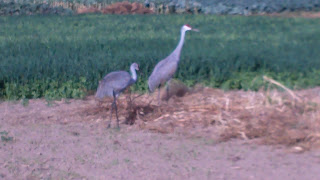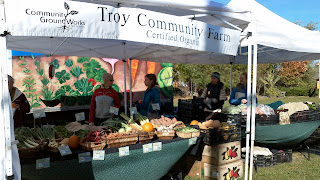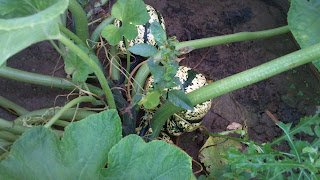We did it! We harvested, packed, and delivered a successful share this past week. Many thanks to the worker shares who rocked it out and did the heavy lifting on Wednesday: Alexa, Roni, Peter, Justin, and Bob. We couldn't have done it without you!
Now that the season has ended, what have I learned? In some ways, I expected this year to have less of a learning curve than last year. Last year everything was new, surely this year wouldn't be as much of a surprise, right? Wrong! Farming includes so many different tasks that you rarely do the same thing multiple times in a row, so you're always on a learning curve.
For example, doing the Wednesday CSA harvest was new to me, thus there were several plants that I had never even learned to harvest last year, much less pack out for delivery. This is because some plants get harvested according to a schedule, so if you aren't working during that time, you may never get to experience that particular vegetable. But I don't have time to go into the specifics of harvesting every last veggie on the farm. Let's just say that I continued to learn things here.
Driving the tractor was a really new experience. I was intimidated by it at first, but discovered despite many imposing looking levers and such, it's really a pretty simple machine that just takes a bit of getting used to. I can't wait to pick out and purchase one of my own.
Cover crop seeding was another new task. This one seemed easier on the surface, but in reality was a bit more difficult. Walk/skipping through newly tilled, lumpy soil is more difficult than it looks. And adjusting the seeder to spit out an appropriate number of seeds can be tricky. But somehow, I even made a mistake calculating the distance between passes on the field, and ended up putting on twice as much seed as was necessary. This made for a great thick mass of crop on certain sections of the field, but meant that I used up seed too quickly and didn't have enough to cover the rest of the farm. Using cover crops to restore fertility to the soil is the foundation of the principles used here at Troy Farm. This was a huge problem, one which I felt just terrible about. Certain seeds, particularly legumes (nitrogen-fixers) are quite expensive and not easily replaced. I'm sure Claire's patience was tested once she figured out what I had done. But being the educator that she is, she prodded us interns to come up with alternative solutions to our seed problems, such as letting the summer cover crop die in the field to hold soil in place, or mowing and tilling at different times in order to let the previous crop's "trash" provide fertility.
One thing I did learn is that when it is your money and your land, you will be the one who loses sleep at night over what to do about your problems. This is both comforting and alarming to me. I can't wait to be the person in charge of my own destiny and business, but I know that it will come with added stress. This happened another time, when I accidentally cut down the remainder of healthy mint in the herb garden. I wasn't around for the instruction and came to the wrong conclusion about what should be done with the remaining mint in the garden. This meant that we lost some of the herb business for wholesaling that week. Luckily, our wholesale customers didn't drop the rest of their orders and we were able to go back to business as usual in a week or two. But if I am not as established as a vendor as Troy is, I may not be so lucky in my own operation.
Generally, I was disappointed in myself over how many mistakes I made in my second year. I don't remember making as many my first year, and I thought they could be prevented. It just goes to show that every year is different, tasks change, and attention to detail must always be maintained. If it doesn't sound quite right, check and double check! You never know when you might take a mistake too far and are unable to fix it.
Of course, the weather provided ample learning opportunities. The weather between the two years I worked differed immensely. The first year was not very hot, normal insect populations, late blight developing on the tomatoes, with rains developing over the fall, and temperatures steadily dropping into October. This year was incredibly rainy up-front, hot and muggy in July and August, with unbearable mosquito populations but not many other insects, threat of late blight (but none happened), and then mild temperatures in the fall.
Of course, this changed what we could work on and when. For example, if it's raining hard, we cannot till the soil, which means we cannot seed or transplant. It also makes it difficult to weed when the weeds are still manageable. This meant that some plants weren't put into the ground on time, and that some weeds got out of control. But it also really changes the attitude of the farmer. Working outside this fall was incredibly pleasant. We were a bit cold in the early morning, but usually the sun came out and we warmed up in no time. Last year, I remember wanting nothing more than to go home and take a hot shower as soon as possible. The nice weather makes it easier to get lots of work done, physically and mentally.
I also learned the value of 'many hands make light work.' Not that I didn't know, but having 3 extra interns this year made the work easier and meant you could switch between tasks readily if you were growing tired of one. I was impressed more than once with our ability to do what seemed like a lot of work in a relatively short span of time. We planted something like 5,000 tomatoes, 3,000 peppers, and 2,000 eggplant in less than 3 hours one day. Amazing! On the flip side, when we were down 4 workers last week during the CSA packout, we could all tell that we were going to have to hustle if we were going to get it done on time.
One last thing I learned had less to do with the farm and more to do with my personal life. I worked 16-24 hours every week on the farm, and another 30 hours at my other job. This was very stressful and difficult at times, especially when I was scheduled at the farm in the morning and then at my other job at night. I learned that I don't really do well in this situation, and that my body has a hard time adjusting to waking up early if I am staying up late.
The biggest lesson I think I learned though is, no matter how much you think you know about farming, there's always more to learn. I'm just going to keep my mind open to as many new experiences and as much new information as I can. There's always next season!




















































